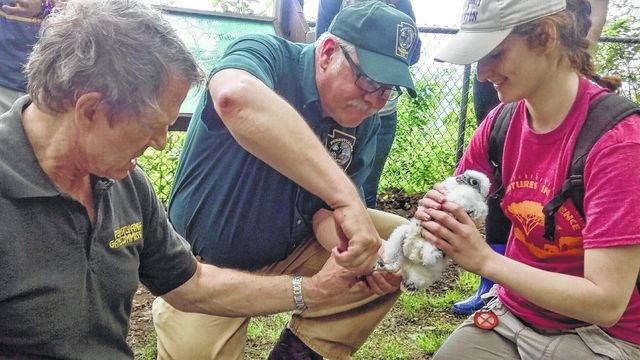Click here to subscribe today or Login.


For nearly an hour Greg Turner hoped the falcon wouldn’t come too close.
Suspended 100 feet down the face of a Luzerne County cliff, Turner, a biologist with the Pennsylvania Game Commission, waited patiently next to a peregrine falcon nest while the female dove threateningly close.
Above the ledge was the cause for the falcon’s fury.
Minutes before, Turner removed two chicks from the nest, where they were hauled up to be examined and banded by Art McMorris, the PGC’s Peregrine Falcon Coordinator.
McMorris and agency staff have been traveling across the state to inspect more than 40 peregrine falcon nests for chicks. The work gives the PGC an idea of how the peregrine population is doing, and it also provides McMorris a chance to gauge the health of the chicks and treat them for any medical issues, such as mites that can feast on growing wing feathers to trichomonaisis – a fatal disease in the upper digestive tract caused by a parasite.
On Monday, Turner and McMorris discovered a pair of chicks and one broken egg in the nest. While the vocal parents flew overhead and threatened to dive-bomb the biologists, the chicks were placed in mesh sacks and carefully carried to the top of the ledge to be examined.
McMorris said some falcon parents are more protective than others.
“Some aren’t that bad, and others want to rip your eyeballs out,” McMorris said. “They have individual personalities, just like people.”
Regardless of their aggressive nature, the peregrines at this particular cliff have been doing their part to give the state-listed endangered population a chance. McMorris said chicks have been fledged from the site every year since 2006, with the exception of 2007 when a helicopter flew close to the cliffs and blew the chicks out of the nest, and again last year when the female disappeared but was replaced by a different bird this year.
The male falcon has been at the nest site since 2007, McMorris said, and a band on its leg determined the bird hatched from a nest in Northampton County in 2005.
With the pair of falcon chicks – a male and a female, safely carried to the top of the ledge, McMorris gave each one a quick exam and estimated their age at around 21 days. He gently rubbed an insecticide dust under their wings to kill any mites, took a swab from their throat to be analyzed at a lab for trichomonaisis, weighed each one and placed identifying bands on each leg.
It’s a process that McMorris repeats at peregrine nests across the state.
“This year is looking pretty similar to last year when we had 43 nesting pairs and 25 fledged chicks,” he said. “We rarely get 100 percent success, but to have more than 50 percent means we’re in the green.”
The Luzerne County cliff site is especially important to the recovery of the peregrine falcon because it is one of the few areas where the raptor is nesting outside of an urban area. Cliffs represent the peregrine’s natural habitat and they are usually a safer place than urban nests such as bridges and buildings.
But cliff nests are hard to get to, and that’s why Turner and McMorris had to repel down the rock face to reach the chicks.
“In the urban areas the chicks are subject to all kinds of threats that the ones here aren’t, such as getting hit by cars, flying into a window, electrocuted by powerlines and even falling out of the nest into a river,” McMorris said. “The cliff nests are important to the recovery of this species.”
With each chick given a clean bill of health and sporting new bands, they were loaded back into the mesh bags. McMorris carefully repelled back down the cliff and handed the chicks to Turner, who dodged the diving parents long enough to put the chicks back in their nest.
“Having two chicks in a nest is average for the state, and this location has been a pretty good one,” McMorris said. “We’re not home free yet when it comes to the peregrine falcon in Pennsylvania, but we’re headed in the right direction.”





